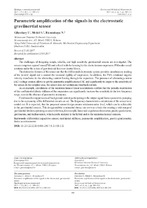| dc.contributor.author | Gilavdary, I. | en |
| dc.contributor.author | Mekid, S. | en |
| dc.contributor.author | Riznookaya, N. | en |
| dc.coverage.spatial | Минск | ru |
| dc.date.accessioned | 2017-06-09T12:27:39Z | |
| dc.date.available | 2017-06-09T12:27:39Z | |
| dc.date.issued | 2017 | |
| dc.identifier.citation | Gilavdary, I. Parametric amplification of the signals in the electrostatic graviinertial sensor = Параметрическое усиление сигналов в электростатическом гравиинерционном датчике / I. Gilavdary, S. Mekid, N. Riznookaya // Приборы и методы измерений : научно-технический журнал. - 2017. – Т. 8, № 2. – С. 108-121. | en |
| dc.identifier.uri | https://rep.bntu.by/handle/data/30452 | |
| dc.description.abstract | The challenges of designing simple, reliable, and high sensitivity graviinertial sensors are investigated. The sensor comprises a proof mass (PM) and is fixed with the housing by the elastic torsion suspension. PM makes small rotations under the action of gravitational forces or inertial forces. The distinctive features of the sensor are that the differential electrostatic system provides simultaneous reading of the desired signal and a control the torsional rigidity of suspension. In addition, the PM's rotational angular velocity transforms in the alternating current flowing through the capacitors. The presence of аlternating current (AC) voltage sources allows to get the parametric amplification of AC and significantly to improve the sensitivity of the sensor. In the simplest case, the sensor does not contain any feedback circuits. As an example, calculations of the micromechanical linear accelerations confirm that the periodic modulation of the coefficient of elastic stiffness of the suspension can significantly increase the sensitivity in the low frequency range, even in the absence of parametric resonance. Conditions for suppressions of background current participating in the output signal from a parametric pumping due to the asymmetry of the differential circuits are set. The frequency characteristics calculations of the sensor were carried out. It is expected, that the proposed sensor design ensures minimum noise level, which can be achievable
in the graviinertial sensors. This design and the constructed theory can serve as a basis for creating a wide range of graviinertial devices operating on a movable base, for example, linear and angular accelerometer, gravity gradiometer, gravimeters, and inclinometers, which can be realized in the hybrid and in the micromechanical versions. | en |
| dc.language.iso | en_US | en |
| dc.publisher | БНТУ | ru |
| dc.subject | Differential capacitive sensor | en |
| dc.subject | Modulated stiffness | en |
| dc.subject | Parametric amplification | en |
| dc.subject | Gravity gradiometer | en |
| dc.subject | Linear accelerometer | en |
| dc.subject | Дифференциальный емкостной датчик | ru |
| dc.subject | Модулированная жесткость | ru |
| dc.subject | Параметрическое усиление | ru |
| dc.subject | Гравитационный градиентометр | ru |
| dc.subject | Линейный акселерометр | ru |
| dc.title | Parametric amplification of the signals in the electrostatic graviinertial sensor | en |
| dc.title.alternative | Параметрическое усиление сигналов в электростатическом гравиинерционном датчике | ru |
| dc.type | Article | ru |
| dc.relation.journal | Приборы и методы измерений | ru |
| dc.identifier.doi | 10.21122/2220-9506-2017-8-2-108-121 | |
| local.description.annotation | Рассматривается задача создания простого, надежного и высокочувствительного маятникового гравиинерционного датчика. Датчик содержит подвижную массу, удерживаемую относительно корпуса с помощью упругого торсионного подвеса. Подвижная масса совершает малые повороты под действием момента силы, обусловленного действием гравитационных сил или силы инерции. Отличительная особенность датчика состоит в том, что дифференциальная электростатическая система обеспечивает одновременное считывание полезного сигнала и уменьшение крутильной жесткости подвеса. Также особенность датчика состоит в том, что его чувствительность определяется угловой скоростью поворота подвижной массы и пропорциональной ей амплитудой переменного тока, протекающего через конденсаторы. Наличие в датчике источников переменного напряжения позволяет осуществлять параметрическое усиление переменного тока и существенно увеличивать его чувствительность. В простейшем варианте в датчике отсутствуют цепи обратных связей. На примере микромеханического линейного акселерометра путем расчетов доказывается, что периодическая модуляция коэффициента жесткости упругого подвеса позволяет существенно увеличить чувствительность прибора в области низких частот, даже в условиях отсутствия параметрического резонанса. Анализируются условия подавления фоновых составляющих тока, проникающих в выходной сигнал от источников переменного напряжения вследствие несимметричности дифференциальной электрической цепи. Подобная конструкция и построенная теория могут служить основой при создании широкого круга различных гравиинерционных приборов, работающих на подвижном основании, таких как линейные и угловые акселерометры, гравитационные градиентометры, гравиметры, наклономеры, виброметры, в том числе в гибридном или микро исполнении. | ru |

